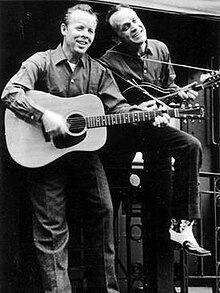R.I.P., Phil Everly
 |
| Phil Everly (L) and brother Don Everly (R) |
The Everly Brothers were there at the inception of rock 'n' roll, becoming perhaps the 1950s' most popular musical duo with hits like "Bye Bye Love," "Wake Up Little Susie," and "Cathy's Clown." They were among the first artists to be inducted into the Rock and Roll Hall of Fame, in 1986. That first Hall of Fame induction included such fellow greats as Chuck Berry, James Brown, Ray Charles, Sam Cooke, Fats Domino, Buddy Holly, Jerry Lee Lewis, Elvis Presley, and Little Richard.
Surprisingly perhaps to today's younger generation, the rock 'n' roll Everlys came out of the country music tradition. You can find out more about their history and legacy by reading "Appreciation: Phil Everly, half of a duo with unearthly sound," an article published in The Washington Post in the wake of Phil's death.
The Beatles, the Byrds, the Hollies, Simon & Garfunkel — all were influenced by the close harmony singing of the Everly Brothers. The Washington Post article says the two brothers "hardly ever sang more than a diatonic third apart." Translation: If Don was singing the note C, Phil would likely be singing an E, just four semitones (a diatonic/major third) up from C. Phil's part was usually parallel to Don's, so if Don hypothetically stopped singing, Phil's voice would be heard spinning out the same exact melody at a slightly higher pitch.
That was a bit unusual, as most close harmony singing is done with varying pitch intervals — albeit with intervals that always stay within a single octave — from one note to the next in the melody.
* * * * *
 |
| Charlie Louvin (L) and Ira Louvin (R) |
Earl and Bill Bolick, the Blue Sky Boys, were another close-harmony country brother act. They performed such songs as "Don't Let Your Sweet Love Die" between 1937 and 1941.
One of the most famous country music close-harmony duos were Charlie Monroe (baritone) and Bill Monroe (high tenor). The Monroe Brothers hit big with such songs as "New River Train" in the mid- to late 1930s. Bill Monroe, Charlie's younger brother, would go on in the 1940s and '50s to become the "Father of Bluegrass Music."
* * * * *
The Everlys' successors in rock 'n' roll included, of course, the Beatles. Here, on YouTube, they sing their first hit, "Love Me Do." John Lennon and Paul McCartney perform the song in close harmony, with John, on lead, singing the higher part, and Paul singing the lower part. (With the Everlys, Don's lower voice would usually sing the lead, with Phil singing tenor harmony.)
 |
| Art Garfunkel (L) and Paul Simon (R) |
Here, in another YouTube video, the Byrds use three-part close harmony on "Eight Miles High" in 1966.
More three-part close harmony with shades of the Everlys: The Hollies' 1966 hit "Bus Stop."
* * * * *
Here are two photos of the Everlys taken on the occasion of their January 23, 1969, show at the Bitter End night club in New York's Greenwich Village — just by sheer luck I happened to be there that night — a place that was huge jump from their down home country roots:
 |
| Don in front with guitar raised, Phil in background |
 |
| Phil (L) with Don (middle) and unidentified man |
In the second photo, notice that Phil is smoking a cigarette. His death was said to be from complications of chronic obstructive pulmonary disorder (COPD). He had been a lifelong heavy smoker. (During that Bitter End show, he probably inhaled second-hand smoke from my own cigarettes. I, too, now have COPD.)
Anyway, God rest you now and preserve your angelic voice, Phil Everly!
Labels: Close Harmony, Simon & Garfunkel, The Beatles, The Blue Sky Boys, The Byrds, The Everly Brothers, The Hollies, The Louvin Brothers, The Monroe Brothers

